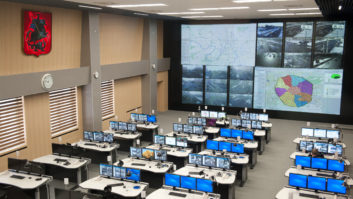The world is more connected than it has ever been – and, if there is one prediction that can be made with absolute certainty, it is that it will become even more connected. Ian McMurray finds out more about the central role being played by matrix switches.
A wise man once said that there are three secrets to success in life. The first is to show up. The second is to be in the right place at the right time. And the third is to have the right cables. Transposing this to the AV world, it’s possible to conclude that showing up on time with the right cables is the key to success.
Inevitably, the reality today is somewhat more complex. We’ve moved from a ‘one-to-one’ cabling world to a ‘many-to-many’ cabling world in which multiple sources need to be cross-connected to multiple destinations, or ‘sinks’. Enter the matrix switch – or matrix switcher, or matrix router.
“Matrix switchers are required when you have multiple input sources that need to be distributed to multiple sink devices,” notes Mark Ridgwell, business development manager, Crestron UK. “Traditionally, smaller localised matrix switchers were used, to allow for signals to be switched within a single room environment. However, recently we have seen a move towards larger centralised matrix switchers. These centralised switchers, such as Crestron’s DM-MD64x64 and DM-MD128x128, allow for multiple signals to be distributed to multiple building-wide destinations.”
“Matrix switches have assumed a more complex role in recent times, becoming the core of any installation,” says Franck Facon, marketing and communications director at Analog Way. “Now, they have brought a completely new concept to the AV industry.”
Constantly amazed
“We’re constantly amazed by the applications our customers find for matrix switchers,” smiles Ezra Ozer, Kramer’s VP of marketing. “Over the last few years, the trend we see is that local audio and video switching is not enough. We’re getting more and more requests for control, extension solutions and audio breakout functionalities. In addition, there is a growing demand for faster and seamless switching. We also see an obvious change with the use of fibre technology that can extend the borders of a typical installation, allowing the matrix switcher to act as the hub of the installation and serve many remote users.”
It’s no surprise, then, that matrix switches are becoming significantly more complex. David Jones, international sales manager at Lightware, picks up the story.
“Only a few years ago, if multiple video, audio and control formats were required in a single system, the installer would basically have to build three or four different systems and somehow link them all together – not to mention the number of conversion boxes that would be required to jump from one format to another or to extend over longer distances,” he points out. “It was pretty standard practice to have 50 or so boxes in a relatively small video distribution system, which in itself created an exceptional level of complexity. Now, the switchers themselves are more complicated, but the system as a whole is far more simple.”
“Yes, there have been huge changes,” echoes Brian Davies, European technology and training director at AMX. “Single-format matrix switchers are all but dead with the market moving towards multi-format switchers, featuring the ability to switch both analogue and digital video, audio signals together with control and other useful signals such as USB and Ethernet. These multi-format products also offer the systems designer much more flexibility and signals can arrive and leave the matrix using multiple different transport media. Traditional VGA, DVI or HDMI connections locally on the switch can be mixed with remote signals arriving via structured cabling solutions or fibre infrastructure, to deliver complex wide-area switching and distribution solutions with ranges up to 10 kilometres.”
SIGNAL complexity
“It’s not so much that switchers are complex, and more about the growing complexity of signal distribution,” adds Michael DiBella, marketing communications manager at Atlona. “Quality switchers only need to be engineered to support the complex signals that they route. In today’s age of digital signal distribution using multiple sources, where signals are coded with content protection, control protocols, and with display identification data then routed to a multitude of displays, switchers need to be engineered to facilitate signal transport. To simplify the process, solution providers such as Atlona offer design services as well as configuration tools that make it easy to maximise performance while also simplifying system design.”
It’s not even just about signal complexity. There is also a proliferation of end devices that need to be accommodated – a point made by Andy Fliss, marketing director at TV One, which joined forces with Magenta in 2011 and subsequently with Gefen to become Nortek’s ProAV Group.
“AV installations have become extremely collaborative environments,” he believes, “and the resulting prevalence of BYOD [bring your own device] is forcing manufacturers to accommodate an increasing variety of source signals. In the old days, expert pro-AV manufacturers would have created interface products to provide universal access to presentation systems – and those specialty peripherals were generally best-of-breed. Now, top-tier manufacturers strive to provide one-stop shopping. The result can often be extremely complex ‘heart of system’ products – matrix switchers – that attempt to be all things to all men.”
“The drawback,” he laughs, “is that we have become an industry of jacks of all trades and masters of none.
“But,” continues Fliss, “the most significant change in the use of matrix switchers is the addition of interactive end-points. Touchscreen displays are sending HID responses back through the matrix for remote control of computer-based content. We see this increasingly in museums, shopping malls with interactive directories and other wayfinding applications.”
Shift in design approach
The demand to cater for a broad range of signal types and end devices – not to mention the wide array of customer environments and applications – has led manufacturers to acknowledge that there can be no ‘one size fits all’ solution. In addition, as AV becomes more integral to business, any given installation has a high likelihood of needing to respond dynamically to changing business requirements – and high reliability and uptime are essential. Beyond this, signal distribution technology is not standing still: the only constant is change. Last but not least is the issue of affordability. This combination of factors has led to something of a shift in the approach to the design of matrix switches.
@page_break@
“Providing modular matrix switchers allows manufacturers to provide solutions to multiple design applications with the same core hardware,” explains Ridgwell, “allowing for a variety of input and output signal types to be combined for each custom installation. Modularity also provides a future upgrade option to a system.”
“It is not possible to build a custom matrix to suit every install so the next best thing is modularity,” notes Jon Lane, managing director at Smart-e. “We can create two or three modular cards – such as an HDMI input card, a VGA input card, an HDMI output card, a Cat5/HDBaseT output card and so on – such that the matrix can then be customised to suit all needs.”
“Modularity adds many advantages to a matrix,” he continues. “Future expansion can be achieved without the need to pay for the extra I/O unit required. Different interface modules allow for mixed signal formats, and future-proofing is achieved by allowing the inclusion of new interfaces we don’t yet know about – the dreaded unknown unknowns.”
Facon has an interesting take on the subject of modularity. “For the systems integration market, modularity allows an AV system to evolve,” he says. “Having a relatively low entry price makes the initial agreement easier, especially with the understanding that the switch can grow with the customer’s needs – but the ability to add features and functionality in line with the changing AV infrastructure can be an asset for the integrator, allowing him to help his customer adapt to the future without facing significant additional cost.”
Custom – and scalable
As DiBella points out, while noting that fixed switchers can have value in many applications: modularity brings a compelling combination of the ability to create a custom solution on the one hand, and a solution that is highly scalable on the other.
“Modularity also ensures that matrix switch design is cost-effective, using only the required number of input and output ports,” adds Davies. “This also means that a modular matrix switch need not be square, such as 8 x 8 or 32 x 32; combinations such as 4 x 16 or 24 x 8 become possible.”
“The other major benefit with using a modular solution is in terms of reliability and long-term support,” he goes on. “Given the large numbers of inputs and outputs available – the largest digital video matrix available from AMX, for example, is 256 x 256 – failure of a matrix switch often impacts on more than just one space; in fact, it can often impact upon the whole facility. Modular designs can allow for the removal and replacement of individual boards rather than the whole switch and hence can vastly reduce the downtime and the time needed to identify and rectify the problem. AMX Enova DGX products take this commitment to support a step further by ensuring all DGX signal boards are ‘hot-swappable’, meaning that only the faulty board need be replaced and that this can be achieved without switching off the matrix and taking the whole facility offline.”
Alternatives
Given everything that matrix switches are capable of, it’s hard to believe that there is any alternative for organisations looking for the functionality they deliver. That’s not necessarily the case, however. One in particular stands out.
“There are a few alternatives to implementing an ‘any-to-many’ video system,” claims Fliss. “The highest-profile alternative is IP video. With IP video, any quantity of multicast video streams can be ‘tuned in’ at decoders located at display locations. The sources can be placed anywhere on the network, as can the displays. This concept is easily understood by IT facility managers and is increasingly chosen, despite the drawbacks. Latency remains an unmanageable variable, resulting in sinks being out of sync with each other. There is also a lack of attention to video quality that becomes a factor in meeting environments.”
Jones also sees IP video solutions as a potential alternative. “With these, you are able to create almost the same functionality utilising a standard network switch as the centre-point,” he says. “These systems can work out quite a bit cheaper than standard routing, but many also have drawbacks. Most IP-based encoders compress the signal and this compression often creates latency from source to sink. In many applications in which Lightware is involved, latency is not accepted even to a single frame. This compression can also create degradation of the signal pathway, which again is unacceptable in most professional applications.”
Largely in agreement is Lane. “The only other way of achieving the same functionality as a matrix would be to use video streaming,” he notes. “Multiple channels can be accommodated on a network which can be decoded at each display. It’s great for distance and using existing cable – but it can affect network bandwidth, and experience problems with timing and delays.”
It seems that IP can deliver similar functionality to a matrix switch – but perhaps not the same performance. Ozer, however, is in no doubt about the way forward.
“It is our belief at Kramer that the market is clearly moving towards using video over IP as the main method for video routing,” he says, noting, however, that the technology still suffers from relatively high entry prices and the absence of standardisation. “The advantages are numerous. It enables building asymmetrical virtual matrix switching solutions with exactly as many inputs and outputs as required; signals can be transmitted over virtually unlimited ranges over the IP network; and solutions are dynamic and modular, so adding more inputs and outputs is possible.”
Kramer recently introduced the KDS-EN2T/R, an HDMI over IP TX/RX set, based on JPEG2000 technology, which sends and receives what the company claims is a visually lossless HD image with digital stereo over a Gigabit LAN, and with zero-delay switching time.
The industry is largely in agreement on the central role that matrix switches play in today’s demanding AV installation. There is, however, less agreement on whether ‘matrix switch’ is the correct term. The last word goes to Brian Davies.
“If you have just one, it’s a matrix switch. If you have more than one, then you have matrix switchers. And,” he laughs, “the collective noun for a group of matrix switchers is an ‘entanglement’.” A wise man indeed. n
www.amx.com
www.analogway.com
www.atlona.com
www.crestron.com
www.kramerelectronics.com
www.lightware.eu
www.smart-e.co.uk
www.tvone.com







